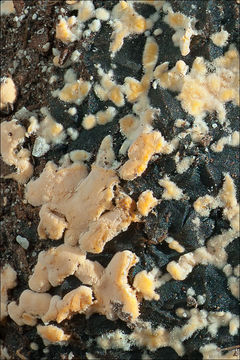Image of Clonostachys rosea (Link) Schroers, Samuels, Seifert & W. Gams 1999

Description:
Syn.: Penicillium roseum Link, Gliocladium roseum Bainier - Habitat: mixed wood, Fagus sylvatica, Picea abies dominant trees; moderately inclined mountain slope, southeast aspect; skeletal, colluvial, calcareous ground; in shade; relatively warm and dry place; partly protected from direct rain by tree canopies; average precipitations ~ 3.000 mm/year, average temperature 7-9 deg C, elevation 560 m (1.840 feet), alpine phytogeographical region. Substratum: on somewhat over-mature Rhizopogon aestivus fruitbody. Comments: Orange blobs on the surface of almost black sporocarp of Rhizopogon aestivus are anamorph form of a parasitic fungus Clonostachys rosea (teleomorph formerly known as Bionectria). This was determined by growing fungus in culture from herbarium sample (Ref.:1). Clonostachys rosea is a common species found on several substrates including other fungi (fungicolous species). It colonizes living plants as an endophyte, can live in ground living as a saprophyte, or lives as a parasite on other fungi or nematodes. It produces several kinds of mycotoxins. It is used in biological pest control on vegetable, mostly for treatment of grey mold (Botrytis cinerea) of tomato and strawberries. The long fusiform and septated conidia also observed belong most probably to another fungus belonging to genus Fusarium. It has not been determined to species level. Small conidia of Clonostachys rosea smooth; dimensions: 4.7 [5.5 ; 5.9] 6.8 x 2.9 [3.3 ; 3.5] 3.8 microns; Q = 1.4 [1.6 ; 1.7] 2; N = 40; C = 95%; Me = 5.7 x 3.4 microns; Qe = 1.7. Fusiform, long, narrowly spindle-shaped, slightly bend conidia dimensions; 35.9 [46.9 ; 51.8] 62.8 x 4.5 [5.2 ; 5.5] 6.2 microns; Q = 6.2 [8.8 ; 9.9] 12.4; N = 31; C = 95%; Me = 49.3 x 5.3 microns; Qe = 9.3; number of septa: AVG = 4.9 (SD = 1.4), N=34. Olympus CH20, NEA 100x/1.25, magnification 1.000 x, oil (small conidia), NEA 40x/0.65, magnification 400x (large conidia, hypha, conidiophores), NEA 10x/0.25, magnification 100x (squash); fresh material; in water. AmScope MA500 digital camera. Herbarium: Mycotheca and lichen herbarium (LJU-Li) of Slovenian Forestry Institute, Vena pot 2, Ljubljana, Index Herbariorum LJF Ref.: (1) Personal communication with Dr.Walter Gams, http://www.ascofrance.com , who has grown a culture and determined the species. (2) https://en.wikipedia.org/wiki/Clonostachys_rosea_f._rosea Nikon D700/Nikkor Micro 105mm/f2.8
Included On The Following Pages:
- Life (creatures)
- Cellular (cellular organisms)
- Eukaryota (eukaryotes)
- Opisthokonta (opisthokonts)
- Nucletmycea
- Fungi (mushrooms, lichens, molds, yeasts and relatives)
- Dikarya
- Ascomycota (sac fungi)
- Sordariomycetes
- Hypocreales
- Bionectriaceae
- Clonostachys
- Clonostachys rosea
This image is not featured in any collections.
Source Information
- license
- cc-by-nc-sa-3.0
- copyright
- 2017 Dr. Amadej Trnkoczy
- photographer
- Dr. Amadej Trnkoczy
- original
- original media file
- visit source
- partner site
- CalPhotos
- ID


